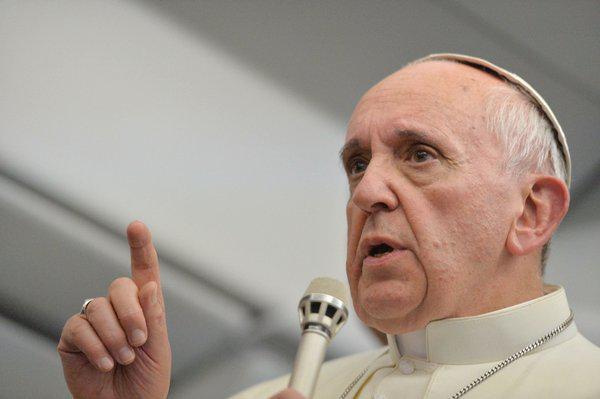|
The Pope and the Pederasts
By Garry Wills
Pope Francis has acted fast on his preferred issues—poverty and economic justice. Nothing in that to criticize. He has been slower—too slow, say some—to deal with the long-festering problem of sex abuse by priests. He has at last taken some of the steps people were calling for—see victims and apologize to them, authorize a panel to study the problem, promise reforms that will prevent a recurrence of these crimes. OK so far—but Pope Benedict had begun all that before him. Why did Francis hesitate to continue what was already being done? Is it because all these things are beside the point? Very likely, they are. Without addressing structural issues in the Vatican, meaningful action to restore trust in the priesthood and church authority cannot get far. There are four such interlocking problems: 1. Celibacy. Yes, celibacy does not directly and of itself lead to sexual predation. There are many unmarried men and women who are not predators. But Catholic celibacy is not simply an unmarried state. It is a mandatory and exclusive requirement for holding all significant offices in the Church. This sets up a sexual caste system that limits vision, empathy, and honesty. It enables church rulers to be blithely at odds with the vast majority of their own people. According to a 2011 Guttmacher Institute study, 98 percent of American Catholic women of child-bearing age have had sex—and, of that 98 percent, 99 percent have used or will use some form of contraception. Yet celibate priests tell us they know what sex is really about (by their expertise in “natural law”), and in their view it absolutely precludes birth control. There is an induced infantilism in such cloistered minds, an ignorance that poses as innocence. This prevents honesty at so many levels that any trust on sexual matters begins in a crippled state, handicapping all treatment of sexual predation in the Church. 2. Homophobia. Pope Francis is often hailed for asking, “Who am I to judge” gay men. The New Yorker headlined its comment on this question (by the estimable Alexander Stille), “Francis Redefines the Papacy.” Hardly. He was speaking within a specific context, after being asked about gay priests in the Vatican (the so-called “gay lobby”). He said, “We must make the distinction between the fact of a person being gay and the fact of a lobby, because lobbies are not good. They are bad. If a person is gay and seeks the Lord and has good will, who am I to judge that person?” But accepting the Lord in the modern priesthood means following the rule of recent popes that homosexuality is morally “disordered” and may not be acted on. He was saying that gay priests who do not have gay sex should not be judged. This is no great advance on the old “hate the sin, love the sinner” line that homophobes regularly use. There are many gay priests, some who remain celibate, some who don’t. The fact that they have to hide their “disorder” does not mean they are not being judged. If they felt they were not being judged, they would not be hiding. Now, when Catholics are agreeing with their fellow Americans that being gay is not a disgrace, and marrying is a gay right, the Vatican cannot even get into the conversation, much less lead it in a useful way. 3. Patriarchy. The Vatican is not only the West’s oldest monarchy, but its most entrenched patriarchy. For long its official teaching was Thomas Aquinas’s assertion (taken from Aristotle) that “the female is a defective male.” Though the Vatican has tried in recent years to back off from that position, as late as 1976 Paul VI’s Curia said that there can be no women priests because women do not look like Jesus: they lack “this ‘natural resemblance’ which must exist between Christ and his minister.” Pope John Paul II said in 1994 that if Jesus had wanted to ordain women, he would have begun with the best of them, his mother. He ignores the fact that Jesus in the Gospels ordained no priests, male or female. The investigation of American nuns for daring to have opinions of their own shows how far Vatican officials are from understanding women. (How could they understand them?) 4. Clericalism. The previous three problems converge on the clerical mindset that afflicts all bureaucracies, but especially sacred ones. Advancement of one’s career involves deference to those above, adherence to corporate loyalties, and a determination not to hurt the institution (demonstrated by signal loyalty). Questioning “church teaching” is subversion. This leads to support of one’s own in all ways possible—as far as one can go, for instance, in denying sin among one’s colleagues. This is the area in which Pope Francis has made some initial moves, challenging the power of the Curia (Rome’s bureaucracy). But challenge is not change, and so long as these structural issues persist, it will be impossible to restore trust in the Vatican’s authority. No pope can change all these things all by himself, even one as winning as Francis is proving. If it is to be done at all, it must be by a joint effort of the whole People of God. Perhaps that is what Francis is waiting for. I suspect he would welcome it.
|
.
Any original material on these pages is copyright © BishopAccountability.org 2004. Reproduce freely with attribution.
